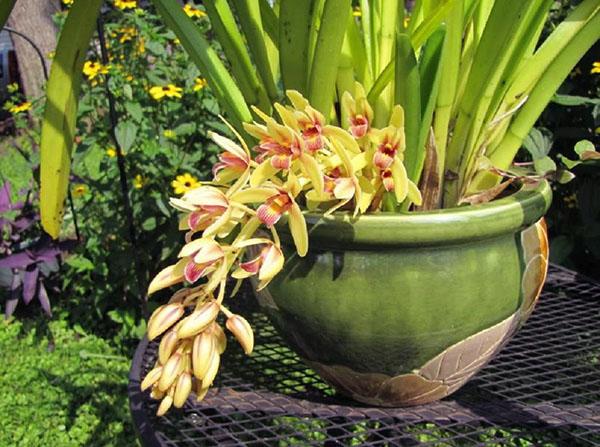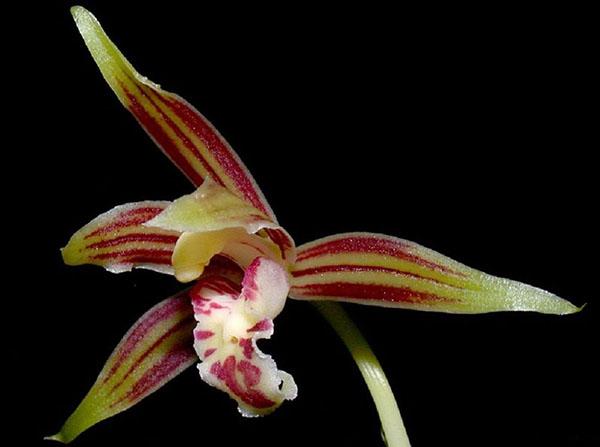Cymbidium orchid - home care and expert advice
 Cymbidium orchid - caring for which requires certain knowledge and skills. It can be grown and propagated at home, and the plant grows well and blooms at room temperature. The Cymbidium variety is considered to be the simplest and most unpretentious in comparison with other varieties of orchids. However, it is important to know the basic rules of how to provide the Cymbidium orchid with home care, in order to observe bright and long flowering every year.
Cymbidium orchid - caring for which requires certain knowledge and skills. It can be grown and propagated at home, and the plant grows well and blooms at room temperature. The Cymbidium variety is considered to be the simplest and most unpretentious in comparison with other varieties of orchids. However, it is important to know the basic rules of how to provide the Cymbidium orchid with home care, in order to observe bright and long flowering every year.
Cymbidium Orchid - description and features

As cultivated plants, Cymbidium began to be cultivated in China over 2000 years ago. Confucius considered him the king of fragrances and distinguished him from all varieties of orchids.
Cymbidium orchid - home care
 Caring for the Cymbidium orchid requires certain skills. In the process of evolution, the plant has adapted to the climate of the subtropics, so it is important to try to recreate it at home.
Caring for the Cymbidium orchid requires certain skills. In the process of evolution, the plant has adapted to the climate of the subtropics, so it is important to try to recreate it at home.
To make the flower as comfortable as possible in a pot, you should adhere to the basic principles:
- long daylight hours - worth buying for orchids special lamps, especially in winter;
- protection from heat and direct sunlight, good ventilation;
- high air humidity - it is recommended to spray the leaves several times a day, as well as a pot with a tray filled with wet expanded clay;
- suitable container and soil - you can buy it at the store or prepare it yourself.
The flowering period is in winter and can last up to 4-6 weeks. However, Cymbidium, like other members of the Orchid family, is sensitive to climatic conditions, so it may not bloom if the basic rules are not followed.
Watering and temperature conditions
 It is important to know how to water Cymbidium so that it does not need moisture and does not rot from its excess. Despite the fact that orchids do not grow in drought conditions, their roots (pseudobulbs) suffer from stagnant water. In this case, black spots can be seen on the leaves, and the plant takes on an unhealthy appearance. With insufficient watering, the root system shrinks, and leaves and flowers fall off.
It is important to know how to water Cymbidium so that it does not need moisture and does not rot from its excess. Despite the fact that orchids do not grow in drought conditions, their roots (pseudobulbs) suffer from stagnant water. In this case, black spots can be seen on the leaves, and the plant takes on an unhealthy appearance. With insufficient watering, the root system shrinks, and leaves and flowers fall off.
When watering Cymbidium orchids, several rules should be considered:
- abundant watering during the warm season, but without stagnant moisture;
- in autumn and winter, it is enough to water the plant once every 2 weeks, if the air temperature is not too high;
- apply immediately after every third watering fertilizers, into wet ground.
Feeding for Cymbidium can be purchased at the store. These flowers do not tolerate organic fertilizers; only purchased mineral mixtures can be used for them. There are special offers on sale for orchids (Kemira, Raduga and others), but to breed them in a weaker dosage. For Cymbidium, half the dose indicated in the instructions is enough.In spring, flowers need an increased nitrogen content, and in the middle of summer it can be reduced and the potassium concentration added. However, orchid fertilizers are also suitable for regular application and will provide sufficient nutrient supply.
It is better to stop feeding Cymbidium in winter. During the flowering period, the plant does not need fertilization.
Temperature regime
 Caring for the Cymbidium orchid at home also includes the selection of a suitable temperature regime. Most species prefer to grow at room temperature - it should not exceed 22 ° C. During dormancy and flowering, you can reduce it to 10-13 доC, otherwise the plant may simply not bloom. In addition, it is desirable to ensure the difference between the temperature during the day and at night - it should be up to 8-10˚С. Cultivars that grow in their natural environment react to the correct temperature regime, and bred hybrids are no longer so sensitive and are more suitable for growing in pots.
Caring for the Cymbidium orchid at home also includes the selection of a suitable temperature regime. Most species prefer to grow at room temperature - it should not exceed 22 ° C. During dormancy and flowering, you can reduce it to 10-13 доC, otherwise the plant may simply not bloom. In addition, it is desirable to ensure the difference between the temperature during the day and at night - it should be up to 8-10˚С. Cultivars that grow in their natural environment react to the correct temperature regime, and bred hybrids are no longer so sensitive and are more suitable for growing in pots.
Soil and transplant
 Reproduction of Cymbidium occurs by dividing the bush. Beginners are advised to purchase an already mature plant and transplant it at home into a suitable container. The Cymbidium pot should be wide, and its depth does not matter. The plant prefers light, well-drained soil with a specific composition. Better to get it in the store, but you can also make it at home from sphagnum, pine bark and dried fern roots. At the bottom of the container, it is worth putting expanded clay or any other drainage that will protect the roots from decay.
Reproduction of Cymbidium occurs by dividing the bush. Beginners are advised to purchase an already mature plant and transplant it at home into a suitable container. The Cymbidium pot should be wide, and its depth does not matter. The plant prefers light, well-drained soil with a specific composition. Better to get it in the store, but you can also make it at home from sphagnum, pine bark and dried fern roots. At the bottom of the container, it is worth putting expanded clay or any other drainage that will protect the roots from decay.
It is recommended to transplant the Cymbidium orchid at home once a year. This procedure can be combined with the propagation of the bush and its division into several parts.
It is carried out according to the algorithm:
- carefully remove the plant from the old pot so as not to damage the root;
- remove old bark and non-viable roots - it is especially important to cleanse the plant from rotten areas;
- separate the daughter bushes with a sharp knife, capturing at least 3 pseudobulbs;
- process the edges of the cut with activated carbon;
- place the plants in new pots without burying the roots below the previous level.
It is impossible to grow Cymbidium from seeds at home. In nature, the plant does reproduce in this way, but the only method for the home is to divide the bush.
Disease and pests
 Most Cymbidium diseases are associated with the inadequacy of the conditions of keeping the needs of the plants. Beginners often make mistakes, to which flowers react with stunted growth, lack of flowering and other signs.
Most Cymbidium diseases are associated with the inadequacy of the conditions of keeping the needs of the plants. Beginners often make mistakes, to which flowers react with stunted growth, lack of flowering and other signs.
Symptoms can indicate a problem that needs to be addressed:
- lack of flowering - incorrect watering and temperature regime;
- drying of leaves - too low air humidity or abundant watering;
- yellowing of the green part of the plant is a sign of root rotting due to bacteria, fungi, or insufficient drainage.
The most common cymbidium pests are aphid, scale insects and spider mites. Treatment consists of treatment with insecticides for orchids, which can always be purchased at a specialized store. A more dangerous mosaic is a viral disease in which the plant will have to be thrown away. Various types of rot and sooty fungus are treatable, but it is important to remove the plant from the pot and cut out any rotten areas.
To make the orchid bloom - expert advice
 How often Cymbidium blooms depends on the growing conditions and care. A healthy plant begins to bloom in winter. Long peduncles appear on it, on which flowers of various shapes and sizes bloom - it depends on the variety. To stimulate the flowering process, you can reduce the frequency of watering and increase the temperature difference between day and night.
How often Cymbidium blooms depends on the growing conditions and care. A healthy plant begins to bloom in winter. Long peduncles appear on it, on which flowers of various shapes and sizes bloom - it depends on the variety. To stimulate the flowering process, you can reduce the frequency of watering and increase the temperature difference between day and night.
There are several reasons why the Cymbidium orchid does not bloom:
- temperature above 22˚С;
- young plants - Cymbidium begins to bloom in the third year of life;
- diseases and pests;
- too intensive watering.
There are hybrids on sale that bloom in spring and autumn. They are less sensitive to conditions of detention and bloom even in the absence of temperature changes. Flowers are no less bright and fragrant, but easier to care for, so they are especially recommended for beginners. If you follow all the rules and take into account the needs of plants, they will annually delight you with a bright and long flowering period.